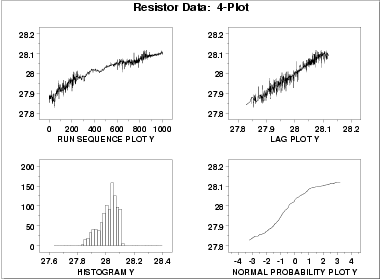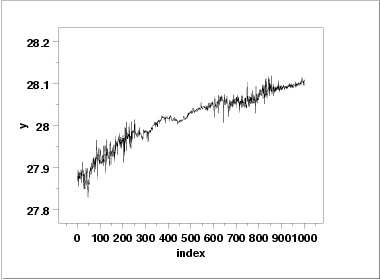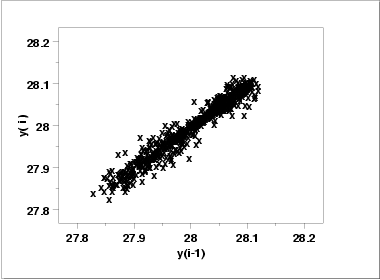1.4. EDA Case Studies
1.4.2. Case Studies
1.4.2.7. Standard Resistor
1.4.2.7.2. |
Graphical Output and Interpretation |
- Determine if the univariate model:
-
\( Y_{i} = C + E_{i} \)
is appropriate and valid.
- Determine if the typical underlying assumptions for an
"in control" measurement process are valid. These assumptions
are:
- random drawings;
- from a fixed distribution;
- with the distribution having a fixed location; and
- the distribution having a fixed scale.
- Determine if the confidence interval
-
\( \bar{Y} \pm 2s/\sqrt{N} \)
is appropriate and valid where s is the standard deviation of the original data.

- The run sequence plot
(upper left) indicates significant shifts
in both location and variation. Specifically, the location
is increasing with time. The variability seems greater
in the first and last third of the data than it does in the
middle third.
- The lag plot
(upper right) shows a significant non-random
pattern in the data. Specifically, the strong linear
appearance of this plot is indicative of a model that
relates Yt to
Yt-1.
- The distributional plots, the histogram (lower left) and the normal probability plot (lower right), are not interpreted since the randomness assumption is so clearly violated.
-
\( Y_{i} = C + E_{i} \)
-
\( Y_{i} = A_0 + A_1*Y_{i-1} + E_{i} \)
- the drift with respect to location was expected.
- the non-constant variability was not expected.
Simple graphical techniques can be quite effective in revealing unexpected results in the data. When this occurs, it is important to investigate whether the unexpected result is due to problems in the experiment and data collection, or is it in fact indicative of an unexpected underlying structure in the data. This determination cannot be made on the basis of statistics alone. The role of the graphical and statistical analysis is to detect problems or unexpected results in the data. Resolving the issues requires the knowledge of the scientist or engineer.



